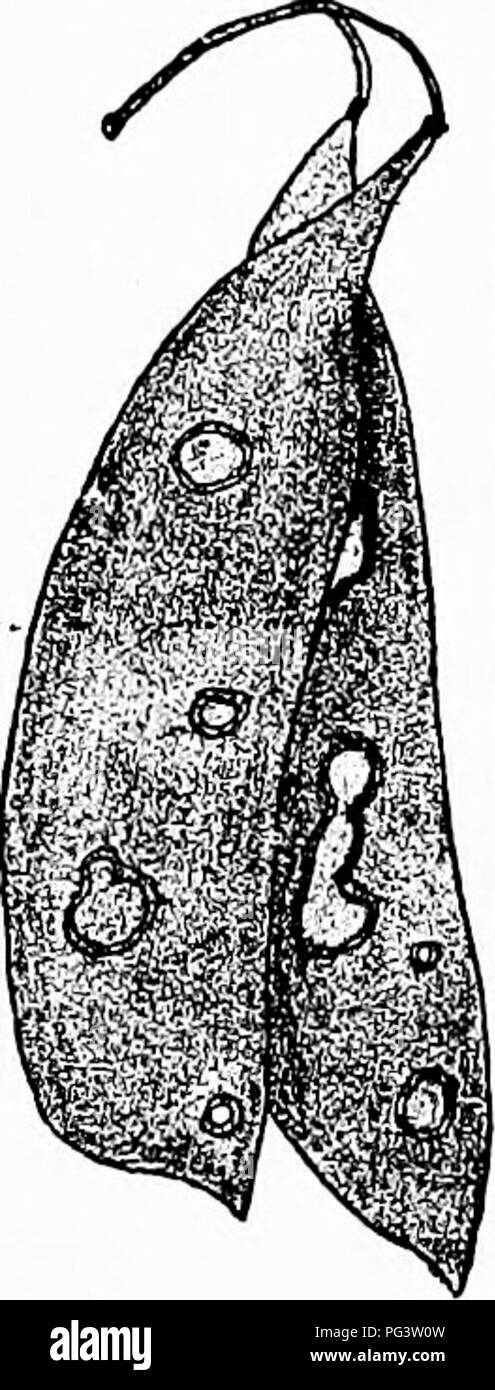. Diseases of plants induced by cryptogamic parasites : introduction to the study of pathogenic Fungi, slime-Fungi, bacteria, & Algae . Plant diseases; Parasitic plants; Fungi. ASCOCHYTA. 473. U8 this fungus is injurious to Pisum sativum, Phaseolus vulgaris, Vicia sativa, etc. It causes spots on leaves and pods, followed by- drying up of the former and deformation of the latter. The pycnidia appear as tiny points on the spots, and give out bicellular cylindrical conidia. As. Boltshauseri Sacc.^ This species was first observed in Switzerland on bean {Plia- seolus vulgaris). Leaves of all ag

Image details
Contributor:
Central Historic Books / Alamy Stock PhotoImage ID:
PG3W0WFile size:
7.1 MB (367.4 KB Compressed download)Releases:
Model - no | Property - noDo I need a release?Dimensions:
976 x 2559 px | 8.3 x 21.7 cm | 3.3 x 8.5 inches | 300dpiMore information:
This image is a public domain image, which means either that copyright has expired in the image or the copyright holder has waived their copyright. Alamy charges you a fee for access to the high resolution copy of the image.
This image could have imperfections as it’s either historical or reportage.
. Diseases of plants induced by cryptogamic parasites : introduction to the study of pathogenic Fungi, slime-Fungi, bacteria, & Algae . Plant diseases; Parasitic plants; Fungi. ASCOCHYTA. 473. U8 this fungus is injurious to Pisum sativum, Phaseolus vulgaris, Vicia sativa, etc. It causes spots on leaves and pods, followed by- drying up of the former and deformation of the latter. The pycnidia appear as tiny points on the spots, and give out bicellular cylindrical conidia. As. Boltshauseri Sacc.^ This species was first observed in Switzerland on bean {Plia- seolus vulgaris). Leaves of all ages become brown-spotted, and premature defoliation may follow. The spots are marked by concentric zones, and bear pycnidia. The conidia are two- to three-celled, being distinguished in this and by their larger size from the preceding species. The following species fre- quent living leaves: Ascochyta tremulae Thlim. On the aspen. A. metulispora, B. et Br. On leaves of the ash in Scotland. A. armoractae Fuck. On Armoracia rusticana (Horse-radish). (Britain.) A. periclymeni Thum. On Lonicera Periclymermm. A. maculans Fuck. On Hed&-a Helix. A. EUisii Thum. On Viiis Lahrusca in America. A. brassicae Thiim. On Brassica oleracea. A. dianthi (A.S.). On Dianthus. (Britain.) A. pallor Berk. On Rubus Idaeus. (Britain.) A. viciae Trail. On Vicia sepium, etc. (Britain.) A. malvicola Sacc. On Malva sylvestris. (Britain.) A. graminicola Sacc. On various grasses. (Brit£||in.) A. scabiosae Rabh. On Knautia arvensis. A. nicotianae Pass. On Nicotiana Tahaccum. A. digitalis Fuck. On Digitalis purpurea. A. fragariae Sacc. has been found injurious to the strawberry crop in the United States. A. aspidistrae given {Gardener's Chronicle, xvii., 1895) as a parasite on Aspidistra in Britain. Fig. 295.—Aacoclnjta pisi on Pea. Enlarged section of pycnidia, and still more enlarged conidia. (t. Tnbeuf del.) ' Boltshauser-Amriswell, Zeitschrift f. PJlanzenh-ankheiten, i., p. 135.. Please note that thes